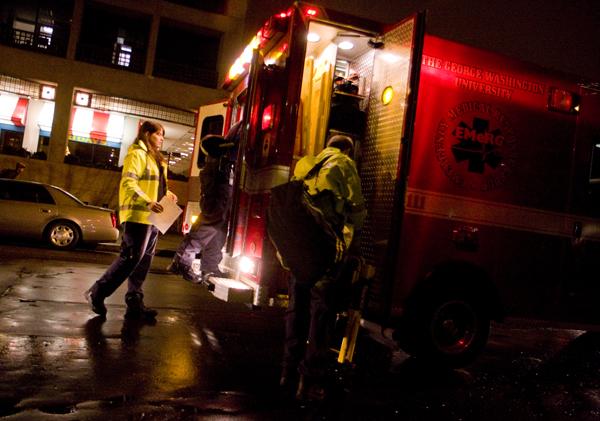The University’s student-run ambulance service hopes to become the first in line to handle 911 calls made on the Foggy Bottom Campus.
EMeRG raised $8,300 for a high-tech dispatch system that will allow the group to take charge of nearly all 911 calls on campus, bringing down costs for students who would otherwise pay between $400 and $800 for treatment by D.C. Fire and EMS.
The group will still need a green light from the University and the city to go forward with plans.
The student emergency medical technicians will be the first team called to offer basic life support for all emergencies in GW-owned buildings, excluding major medical emergencies such as a heart attack or stroke, which require a paramedic.
EMeRG raised the money for the new iMobile system, which pinpoints the location of all 911 calls, in just two days through a crowd-funding website.
“It’s something that will allow us to make sure that we’re servicing literally the entire GW community to the fullest of our capabilities,” Kirsten Hartwick, a senior and the group’s president, said.
Hartwick said she believed EMeRG would be the first college-based emergency responders to fully integrate with a major city’s 911 system – another big step forward for a group that only started using its own ambulance five years ago.
The group will also continue to field the roughly 30 calls a week from the University’s emergency line. The new system will ensure that students and faculty who may not know the University’s emergency line, or fail to remember it during an emergency, can still access EMeRG’s free care.
“You’re told as soon as you can talk and read that you’re supposed to dial 911 in an emergency, so [iMobile] will really catch all of those calls that we’re missing,” Hartwick said.
EMeRG arrives at campus emergencies about three times faster than D.C. Fire and EMS, which responds to calls on campus in about 12 minutes.
The student responders also recently began responding to medical emergencies across the city during high-demand times.
When a sweeping fire broke out in the city this summer, the city’s central dispatch asked EMeRG to help field 911 calls while other city crews responded to the fire. Since then, EMeRG officials said they have worked in a reserve capacity for the city, helping to assist D.C. Fire and EMS while crews mobilized during the Washington Navy Yard shooting last month.
Because the EMeRG crew does not include a paramedic, Engine 1 on M Street would still respond to cases involving severe bleeding, cardiac or respiratory issues. The other local D.C. Fire and EMS engine, located on the same G Street block as EMeRG headquarters, also doesn’t have a paramedic.
The city’s emergency response team, which faces a shortage of paramedics and ambulances, has struggled to keep pace with the growing number of calls.
Calls to 911 in D.C. have increased by 22 percent over the past four years, but D.C. Fire and EMS continued to deploy the same number of ambulances, according to a report from the Council’s public safety committee. Since last year, fewer than 4 percent of shifts have been fully staffed.
The report prompted GW Law School professor and D.C. Council member Mary Cheh to put pressure on the city’s fire chief to step down this summer. Since then, the District has added nine paramedics and begin to train 18 more, said Kenneth Lyons, president of the EMS union.
While he called EMeRG’s attempts to integrate the city’s 911 system a “great opportunity,” Lyons said he didn’t see a need for EMeRG to fill a gap in the city’s response capacity.
And because 911 calls from a cell phone don’t give dispatchers a specific address, Lyons said he worried that adding EMeRG to the central dispatch system could “cause some added confusion.”
About 100 people, mainly friends, family, and EMeRG volunteers and alumni, donated to help EMeRG purchase the iMobile system. The group will continue to accept donations to eventually equip their two other vehicles with the same device.
– Jeremy Diamond and Brianna Gurciullo contributed to this report.







